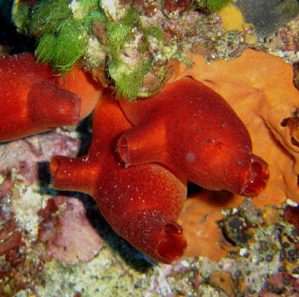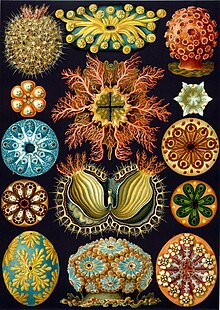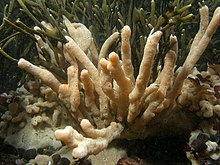Sea squirts
| Sea squirts | ||||||||||||
|---|---|---|---|---|---|---|---|---|---|---|---|---|

Red Sea Squirt ( Halocynthia papillosa ) |
||||||||||||
| Systematics | ||||||||||||
|
||||||||||||
| Scientific name | ||||||||||||
| Ascidiae | ||||||||||||
| Nielsen , 1995 |
Sea squirts (Ascidiae or Ascidiacea) are sessile tunicates that colonize the world's oceans from the shelf to the deep sea . With around 3000 species, they are the most species-rich group of tunicates. The sea squirts are one of the most successful groups of animals because of their ability to form a mantle and, as internal microfilterers, they can exploit the productivity of the free water body.
features
The following three types are distinguished according to the habit, not taxonomically
- Solitärascidien who always Oozooid represent
- Social ascidians, usually with stolons connected
- Synascidia, colonial forms with a common mantle, vascular system, often grouped together outflow siphons in a cloacal space of the mantle and with the most diverse arrangement of the mostly very small individual animals

Their external appearance is very varied due to the populated habitats. Species of the sand gap system ( Mesopsammon ) only reach millimeter size ( e.g. Psammostyela delamarei , Diplosoma migrans ). The sub-Antarctic solitary ascidia Molgula gigantea reaches sizes of up to 30 cm. In the 80 cm long stalked deep-sea ascidia Culeolus murrayi , the actual body measures only about 8 cm. The synascidia Aplidium conicum forms massive colonies up to 50 cm high. Finally, thin ribbon-shaped colonies 4-43 m in length also exist. In the coat of the sea squirt there are mesenchymatic cells that can contain a wide variety of dyes. The smallest species is Molgula hydemanni , which has a diameter of 2 mm. The largest species is Molgula gigantea . It becomes 33 cm long.
Way of life
Adult sea squirts are sessile, but the larvae swim freely.
development

Sea squirts - just as, for example, man - to the chordates , which means they have at certain stages of development same organs: a rod-shaped back support, notochord called, is the in vertebrates developed a spine. The chord data features can only be seen in the sea squirts in the larval stage . In the larval stage, the sea squirt almost completely matches the larva of vertebrates.
The brain structure, which is present in the larval stage and needed for orientation and movement, has completely disappeared in the adult sessile animal. Due to regression, only one ganglion (nerve ball) is left.
Reproduction
Sea squirts are simultaneous hermaphrodites . But asexual reproduction through bud formation is also widespread.
During sexual reproduction of the sea squirts, "tailed larvae" arise. "After a short lifespan" these develop into a fixed ascidia by means of "complex conversion processes". Furthermore, many species of the sea squirt are also capable of vegetative reproduction - "in connection with the ability to regenerate". Individual animals then close together and colonies develop.
nutrition
Almost all sea squirts are food strudel. The water is fed into the gill intestine via an inflow opening, a special formation in which the food is filtered out and then passed through gill slits into the peribranchial space . The gill gut is highly developed. It often contains thousands of gill slits. All particles that are less than 1 μm in size get stuck in it. The filtered water is then released again through the outlet opening. Soluble metabolic end products are also excreted via the gill intestine. The intestine is U-shaped.
In January 2009, a species was discovered in the Australian deep sea southeast of the island of Tasmania at a depth of 4000 meters which feeds on smaller fish that are caught inside the sea squirt , similar to the Venus flytrap .
ecology
The ability to selectively settle via a swimming larva with good sensory capabilities, to spread vegetatively very quickly under favorable conditions and also to reproduce sexually makes the sea squirts successful compared to other sessile organisms. For example, mass developments of Cionia intestinalis are known that reach individual densities of 1500 to 5000 per m². Sea squirts make up more than half of all sessile species on the Corallinaceae soils of the Mediterranean . The representatives of the genus Microcosmus are particularly common here .
Systematics
The sea squirts are classified among the tunicata, which belong to the tribe of the Chordata. There are two orders, three suborders, 15 families.


- Order Enterogona . The unpaired gonads lie in or behind the bowel loop, the cloacal cavity develops from a pair of dorsal invaginations.
- Suborder Aplousobranchia Lahille, 1887
- Family Clavelinidae Forbes & Hanley, 1848
- Didemnidae Giard family , 1872
- Polycitoridae Michaelsen family , 1904
- Polyclinidae family Milne-Edwards, 1841
- Suborder Phlebobranchia Lahille, 1887
- Family Agnesiidae Michaelsen, 1898
- Family Ascidiidae Herdman, 1882
- Family Cionidae Lahille, 1887
- Corellidae family
- Family Diazonidae Garstand, 1891
- Family Hypobythiidae Sluiter, 1895
- Family Perophoridae Giard, 1872
- Suborder Aplousobranchia Lahille, 1887
- Order Pleurogona . The unpaired gonads lie on the left and right of the body wall, the cloacal cavity develops from an unpaired dorsal invagination.
- Suborder Stolidobranchia Lahille, 1887
- Family Molgulidae Lacaze-Duthiers, 1877
- Family Pyuridae Hartmeyer, 1908
- Family Styelidae Sluiter, 1895
- Suborder Stolidobranchia Lahille, 1887
biodiversity
There are currently around 3000 described species worldwide.
Distribution in Germany
About 24 species have been identified in "German marine waters". 19 of these species are found in the Helgoland area . There are also some neozoa among them . One species - it is not a neozoon in the Heligoland area - is distributed worldwide: Ciona intestinalis .
Use by humans
Pickled sea squirts of the Pyuridae family Halocynthia roretzi (Japanese 海 鞘hoya , Korean . 멍게 meongge , English sea pineapple ) are eaten in northern Japan and Korea.
Individual evidence
- ↑ a b c d Wolfgang Groepler: The sea squirts of Helgoland. Biology and determination of the ascidia. Westarp Wissenschaften-Verlagsgesellschaft 2012, p. 6, ISBN 978-3894329174
- ↑ a b c d Alfred Goldschmid: Chordata, Chordatiere. in: Westheide, Rieger (ed.): Special Zoology. Part 1: Protozoa and invertebrates. Gustav Fischer, Stuttgart / Jena 1997, 2004; ISBN 3-8274-1482-2
- ↑ a b C.G .: Lexicon of Biology: Seescheiden. In: Spectrum Academic Publishing House, Heidelberg. 1999, accessed September 1, 2018 .
- ↑ Researchers discover completely new animal world. In: Spiegel Online. January 18, 2009, accessed December 5, 2014 .
- ↑ Scientists discover new marine life off Tasmania - International Herald Tribune (English)
- ↑ tabibito (Matthias Reich): Japan Almanac: Everything about life and travel in Japan. Since 1998. In: Japan Almanach. November 19, 2008. Retrieved September 23, 2018 .
literature
- Svein A. Fossa and Alf Jacob Nilsen: Coral Reef Aquarium , Volume 6, Birgit Schmettkamp Verlag, Bornheim, ISBN 3-928819-18-6
- CG: Lexicon of Biology: Seescheiden, Spektrum Akademischer Verlag, Heidelberg. 1999
- Wolfgang Groepler: The sea squirts of Heligoland. Biology and determination of the ascidia, Westarp Wissenschaften-Verlagsgesellschaft 2012, ISBN 978-3894329174
Web links
- Integrated Taxonomic Information System Ascidiacea
- Ascidiacea.com (Engl.)
- The Dutch Ascidians Homepage (Engl.)
